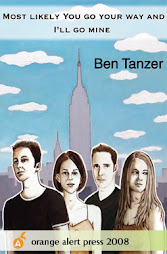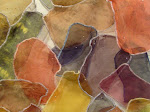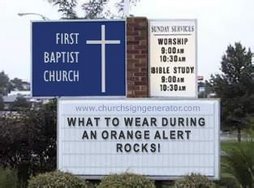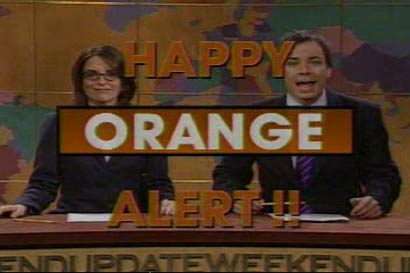
David McNamara
Where would the writer be without the publisher and printer? Standing on a street corner, shouting from rooftops, posting poems on myspace? The independent publisher is a dedicated soul, not concerned with wealth, but concern for the advancement of the written word. He/She fantasizes about the weight and texture of paper and dreams about fonts. Cherishing that perfect cover and seeking out the next great voice. Ok, that may be a bit of an oversell, but David McNamara has honestly put his heart, soul, and money into making sunnyoutside one of the finest independent presses in the country.
Originally conceived as a literary journal in November of 2000, sunnyoutside wasn't officially launched as an imprint until 2004. Since that time they have produced 29 books and broadsides. Some paperback and some saddle-stitched, but all crafted with care and respect to the words, thoughts, and ideas inside.
Recently, David was kind enough to answer a few of my questions.
Orange Alert (OA): In 2004 you made the move from on-line journal to small press, what factors prompted this move? Looking back, is there anything you would have done differently?
David McNamara (DM): The other day I was actually thinking about this, and thought how I wished we jumped into books sooner. But the truth is that everything I had printed earlier was done offset and things had changed so quickly with digital printing that it was probably good that I took the time to survey the landscape a bit. Also it was a lot of fun to do the broadsheets and little pieces and to work with the people those involved—for example, it was great to work with John Sweet again (we had done a split chap published by Crimson Leer Press years earlier) and to work with justin.barrett while he was still writing, and projects with Jason Heroux, Nathan Graziano, William Taylor Jr., and Michael Kriesel all led to bigger things, and through the Heroux broadsheet I met and worked with Bill Roberts of Bottle of Smoke Press, which was fantastic in itself.
So when you consider all of that, no, I don’t think I there are any grounds for complaint.
OA: Is there a certain quality that you look for in a manuscript? How many submissions do you receive in a month?
DM: There’s not a checklist of things I look for in a manuscript, but generally I prefer crafted work that has an extra dimension to it. But at the same time it has to be concise and efficient with its words. If it’s narrative work, it has to have depth beyond a journal entry or stream of consciousness. But definitely work that isn’t totally obscure—an ideal hybrid of emotive and cerebral. The work has to be poignant.
Since we don’t read unsolicited submissions, there aren’t too many new submissions coming in during the average month. I probably have a look at about two new submissions a month while juggling up to a half-dozen manuscripts through editorial.
OA: Is there someone out there that you would love to see involved with Sunnyoutside Press?
DM: I’m pretty lucky to have the stable of authors we currently have at sunnyoutside, so I’m mostly just glad to have the opportunity to work with those individuals. But there’s always the larger-than-life names that I’ve always been fond of—Charles Simic, Donald Hall, Billy Collins—that I’d love to have a chance to work with. I’ve always wanted to publish something by Bill Maher, too, and maybe someone like P.J. O’Rourke. Non-fiction writers like Bill Bryson, Lawrence Millman, Tim Cahill. But all those people are probably under contract somewhere even if they were to take a sniff at a wee little press like sunnyoutside.
OA: Your books come in many different sizes and shapes, with varying types of paper and cover images. How important is the appearance of chapbook? What role do you play in that process?
DM: The appearance is essential. It’s why sunnyoutside exists. The old saying is that the typeface is the clothes you dress your words in, and I think that’s certainly true. Taking it further, Bruce Rogers, arguably the greatest book designer who ever lived, stressed the importance of looking at the book as a whole—the measure, leading, the font’s x-height and point size, margins, trim size, are all interdependent variables. If you change one, you have to go back and look at everything else.
I try to approach the art and typeface and paper in the same way, too. Nothing goes to print without a hard copy proof to make sure there’s a balance to the eye. Or at least I hope that’s the end result.
We’re admittedly a bit low-brow by Rogers’s standards, but, then again, he also said that he designed one-hundred books before he got it right. Hopefully I’m on the right path.
As for my role, I have done the text layout for all of our books and have done the covers for all but one—the wonderful cover of the first impression of Rumors of Electricity by Richard Krech was done by Kseniya Thomas—and have commissioned most of the art specifically for a title.
OA: What are your thoughts on print-on-demand vs. offset printing?
DM: Offset printing is still superior to digital printing, although first I think you have to clarify what it’s being compared to—some printers still define print-on-demand as a thousand books or less while the more contemporary usage is to mean one at a time, as the orders come in. As for the latter, most of the work I’ve seen has been less than impressive, although I think that’s more a case of the company’s business model than the technological capabilities. But some digital printing is very, very close to offset quality, at least with k/k text. The pre-press work is also a major variable—I’ve seen different books that have come off the same press that look vastly different in quality.
OA: What's next for David McNamara and Sunnyoutside Press?
DM: Well, we hope to have distribution by the end of the year, and possibly even much sooner, which will hopefully be a massive step. I’ve recently been asked to be on the advisory board of the Western New York Book Arts Collaborative, which is in an exciting stage of its history—they’re on the verge of buying a building in downtown Buffalo in which to set up offices and workshops. We’re just trying to stay busy and keep improving and growing.
As for books, I’m quite excited with the list of forthcoming titles. We should have works by the following all out by the end of the year, with some much sooner: Noel Sloboda, Taylor Altman, Hosho McCreesh, Andrew Taylor, William Taylor Jr., Brian McGettrick, Alan Catlin, and Michael Kriesel. And we’ve just signed our first contract for a non-fiction book—a collection of essays by Curtis Smith.
Bonus Questions:
OA: Coffee? If yes, what is your favorite type of coffee and where is your favorite coffee spot? Is there different between Seattle and Buffalo as far as coffee is concerned?
DM: Most definitely—I’m a half-pot-a-day drinker. I probably prefer Indonesian Sumatra the most, although I’ve been particularly fond of an organic Nicaraguan lately, which I’m drinking now. My favorite micro-roaster is probably your very own Intelligentsia, who also did the roasting for my favorite coffee shop in the Boston area, Diesel Café. I’m also quite fond of George Howell’s Terroir, who is the roaster for my other favorite café in Somerville, True Grounds.
There’s actually a pretty big difference in coffee between Seattle and Buffalo, on multiple levels. It sounds cliché, but it was actually pretty hard to get a bad cup of coffee in Seattle. Seattle also has a thriving economy, so you had multiple spots in the same area to choose from, all of which were open relatively late. Same in Somerville—Diesel is open to midnight, if I recall. Here in Buffalo the one true local coffee shop near me closes at 6 p.m. every day. There’s a regional chain that’s decent enough, although none of the locations are convenient; a sweets shop that has excellent espresso that’s open until later; and a wonderful greasy spoon on our block that’s open until 9 p.m., but there’s not much else for independent coffee shops. It’s pretty much Starbucks, Tim Hortons, or Dunkin Donuts beyond those. But we’re relatively new here, so I’m sure there are gems we’ve yet to discover, too.
OA: What type of music do you listen to? Who are a few of your current favorites?
DM: I have as hard a time describing the music I like as I do what I look for in a manuscript, I suppose. I like a pretty wide range, although I suppose the core of it would be called independent, although I’m not really sure that’s a useful qualifier.
Some of my all-time favorites, in no particular order: Charles Mingus, Shellac, McClusky, The Clash, PJ Harvey, The Murder City Devils, Smog, Superchunk, Modest Mouse, Hayden, Fugazi, Sleater-Kinney, Archers of Loaf, Mule, Built to Spill, DJ Shadow, Jesus Lizard, June of 44, Mule, Poster Children, Rye Coalition, Railroad Jerk, Tom Waits, Pavement, Jets to Brazil.
Orange Alert (OA): In 2004 you made the move from on-line journal to small press, what factors prompted this move? Looking back, is there anything you would have done differently?
David McNamara (DM): The other day I was actually thinking about this, and thought how I wished we jumped into books sooner. But the truth is that everything I had printed earlier was done offset and things had changed so quickly with digital printing that it was probably good that I took the time to survey the landscape a bit. Also it was a lot of fun to do the broadsheets and little pieces and to work with the people those involved—for example, it was great to work with John Sweet again (we had done a split chap published by Crimson Leer Press years earlier) and to work with justin.barrett while he was still writing, and projects with Jason Heroux, Nathan Graziano, William Taylor Jr., and Michael Kriesel all led to bigger things, and through the Heroux broadsheet I met and worked with Bill Roberts of Bottle of Smoke Press, which was fantastic in itself.
So when you consider all of that, no, I don’t think I there are any grounds for complaint.
OA: Is there a certain quality that you look for in a manuscript? How many submissions do you receive in a month?
DM: There’s not a checklist of things I look for in a manuscript, but generally I prefer crafted work that has an extra dimension to it. But at the same time it has to be concise and efficient with its words. If it’s narrative work, it has to have depth beyond a journal entry or stream of consciousness. But definitely work that isn’t totally obscure—an ideal hybrid of emotive and cerebral. The work has to be poignant.
Since we don’t read unsolicited submissions, there aren’t too many new submissions coming in during the average month. I probably have a look at about two new submissions a month while juggling up to a half-dozen manuscripts through editorial.
OA: Is there someone out there that you would love to see involved with Sunnyoutside Press?
DM: I’m pretty lucky to have the stable of authors we currently have at sunnyoutside, so I’m mostly just glad to have the opportunity to work with those individuals. But there’s always the larger-than-life names that I’ve always been fond of—Charles Simic, Donald Hall, Billy Collins—that I’d love to have a chance to work with. I’ve always wanted to publish something by Bill Maher, too, and maybe someone like P.J. O’Rourke. Non-fiction writers like Bill Bryson, Lawrence Millman, Tim Cahill. But all those people are probably under contract somewhere even if they were to take a sniff at a wee little press like sunnyoutside.
OA: Your books come in many different sizes and shapes, with varying types of paper and cover images. How important is the appearance of chapbook? What role do you play in that process?
DM: The appearance is essential. It’s why sunnyoutside exists. The old saying is that the typeface is the clothes you dress your words in, and I think that’s certainly true. Taking it further, Bruce Rogers, arguably the greatest book designer who ever lived, stressed the importance of looking at the book as a whole—the measure, leading, the font’s x-height and point size, margins, trim size, are all interdependent variables. If you change one, you have to go back and look at everything else.
I try to approach the art and typeface and paper in the same way, too. Nothing goes to print without a hard copy proof to make sure there’s a balance to the eye. Or at least I hope that’s the end result.
We’re admittedly a bit low-brow by Rogers’s standards, but, then again, he also said that he designed one-hundred books before he got it right. Hopefully I’m on the right path.
As for my role, I have done the text layout for all of our books and have done the covers for all but one—the wonderful cover of the first impression of Rumors of Electricity by Richard Krech was done by Kseniya Thomas—and have commissioned most of the art specifically for a title.
OA: What are your thoughts on print-on-demand vs. offset printing?
DM: Offset printing is still superior to digital printing, although first I think you have to clarify what it’s being compared to—some printers still define print-on-demand as a thousand books or less while the more contemporary usage is to mean one at a time, as the orders come in. As for the latter, most of the work I’ve seen has been less than impressive, although I think that’s more a case of the company’s business model than the technological capabilities. But some digital printing is very, very close to offset quality, at least with k/k text. The pre-press work is also a major variable—I’ve seen different books that have come off the same press that look vastly different in quality.
OA: What's next for David McNamara and Sunnyoutside Press?
DM: Well, we hope to have distribution by the end of the year, and possibly even much sooner, which will hopefully be a massive step. I’ve recently been asked to be on the advisory board of the Western New York Book Arts Collaborative, which is in an exciting stage of its history—they’re on the verge of buying a building in downtown Buffalo in which to set up offices and workshops. We’re just trying to stay busy and keep improving and growing.
As for books, I’m quite excited with the list of forthcoming titles. We should have works by the following all out by the end of the year, with some much sooner: Noel Sloboda, Taylor Altman, Hosho McCreesh, Andrew Taylor, William Taylor Jr., Brian McGettrick, Alan Catlin, and Michael Kriesel. And we’ve just signed our first contract for a non-fiction book—a collection of essays by Curtis Smith.
Bonus Questions:
OA: Coffee? If yes, what is your favorite type of coffee and where is your favorite coffee spot? Is there different between Seattle and Buffalo as far as coffee is concerned?
DM: Most definitely—I’m a half-pot-a-day drinker. I probably prefer Indonesian Sumatra the most, although I’ve been particularly fond of an organic Nicaraguan lately, which I’m drinking now. My favorite micro-roaster is probably your very own Intelligentsia, who also did the roasting for my favorite coffee shop in the Boston area, Diesel Café. I’m also quite fond of George Howell’s Terroir, who is the roaster for my other favorite café in Somerville, True Grounds.
There’s actually a pretty big difference in coffee between Seattle and Buffalo, on multiple levels. It sounds cliché, but it was actually pretty hard to get a bad cup of coffee in Seattle. Seattle also has a thriving economy, so you had multiple spots in the same area to choose from, all of which were open relatively late. Same in Somerville—Diesel is open to midnight, if I recall. Here in Buffalo the one true local coffee shop near me closes at 6 p.m. every day. There’s a regional chain that’s decent enough, although none of the locations are convenient; a sweets shop that has excellent espresso that’s open until later; and a wonderful greasy spoon on our block that’s open until 9 p.m., but there’s not much else for independent coffee shops. It’s pretty much Starbucks, Tim Hortons, or Dunkin Donuts beyond those. But we’re relatively new here, so I’m sure there are gems we’ve yet to discover, too.
OA: What type of music do you listen to? Who are a few of your current favorites?
DM: I have as hard a time describing the music I like as I do what I look for in a manuscript, I suppose. I like a pretty wide range, although I suppose the core of it would be called independent, although I’m not really sure that’s a useful qualifier.
Some of my all-time favorites, in no particular order: Charles Mingus, Shellac, McClusky, The Clash, PJ Harvey, The Murder City Devils, Smog, Superchunk, Modest Mouse, Hayden, Fugazi, Sleater-Kinney, Archers of Loaf, Mule, Built to Spill, DJ Shadow, Jesus Lizard, June of 44, Mule, Poster Children, Rye Coalition, Railroad Jerk, Tom Waits, Pavement, Jets to Brazil.
For more on David McNamara and sunnyoutside visit their website and buy their books!
+by+Nick+Volkert).jpg)





















5 comments:
great interview. david is a true artist and really loves his work.
you can tell.
can't wait for the McCreesh and McGettrick
wow, David! great interview, m'man. i think sunnyoutside is the premiere publisher in the small press scene. you have definitely set the standard for the rest of us publishers to follow. keep up the great work.
Great to work with, and possessing a great eye for detail, David McN/sunnyoutside is the fo fo fo foshizznizzle.
You've done it again. Thanks Mr. Orange guy. :)
Plenty of great books to be found in sunnyoutside's catalogue. Save up a few pennies & buy something folks, you will not regret it!
Post a Comment